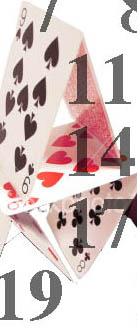
Innovation: “I Can Look At Your Cards”
Oliver’s experimentation in CW often means creating smaller games-within-the game. One is called “Destructive” and another (cryptically) “Jack Slave.” In the latter, Oliver declares that he can look at my cards and force my play. Also surprising is when Oliver renames cards (“Now, I play Queen Mary”) or transforms certain cards into others (“Jack turns into Queen) and, I suppose, because I don’t object (something, I should note, that Yu-gi-oh players do all the time when a player tries something that isn’t kosher), Oliver takes it as green light to go ahead with his move. Oliver is learning deeply here by registering the impact of his innovations on me (and on himself). My purpose in playing CW during the time I shot the footage was to get him to talk about and demonstrate the game, but usually I offer him more resistance to some of his gambits.
It is possible to consider Oliver’s innovations in CW as evidence of what Gee calls “critical” learning, something he distinguishes from active learning in so much as it involves thinking about a domain at “the ‘meta’ level as a complex system of interrelated parts” and thus learning to “innovate…to produce meanings that, while recognizable, are seen as somehow novel or unpredictable” (23). Thinking pedagogically (or about good game design), Gee suggests that opportunities for players to think critically while playing games should not come at the end, should not be structured as an “an add-on” after a great deal of active learning has taken place; they should be “central to the process of active learning from the very beginning” (47). I think what Gee is suggesting here is that deep learning does not occur “in stages” where the learner must first learn and religiously adhere to the rules only later to loosen up and play around some. Embodied learning requires a person to practice at something a great deal of time without getting bored and this often means sometimes breaking the rules, doing what is necessary to experience the game as something that can be “played with” and not just played (176).
One: Situating Embodied Learning
-
Identity and Learning: “Follow What I Am Doing: Do The Rules That I’m Doing: It’s Very CoM-pli-cated”
- Producelike Behavior: "Why Do The Make Queen Better Than Jack?"
- Conclusion: "The Bricolage, The Music, The Movement"
Three: Implications for the Literacy Autobiography Assignment
